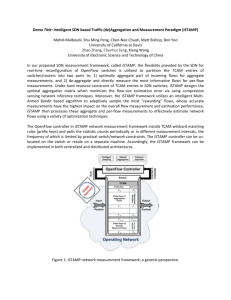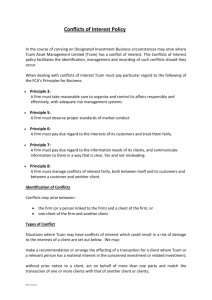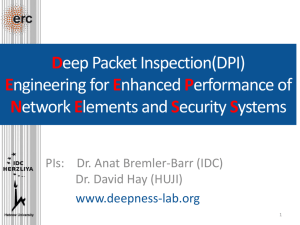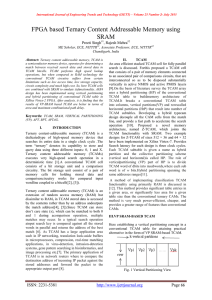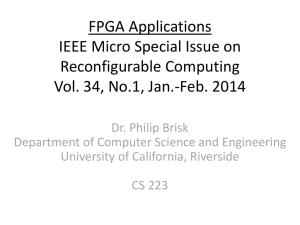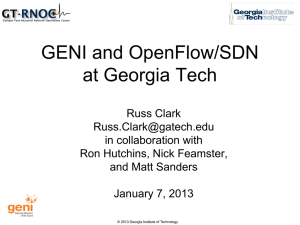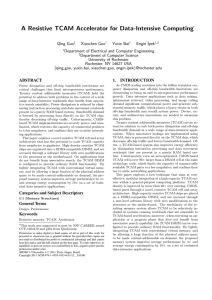TCAM Performance Analysis and Model - CSIE -NCKU
advertisement
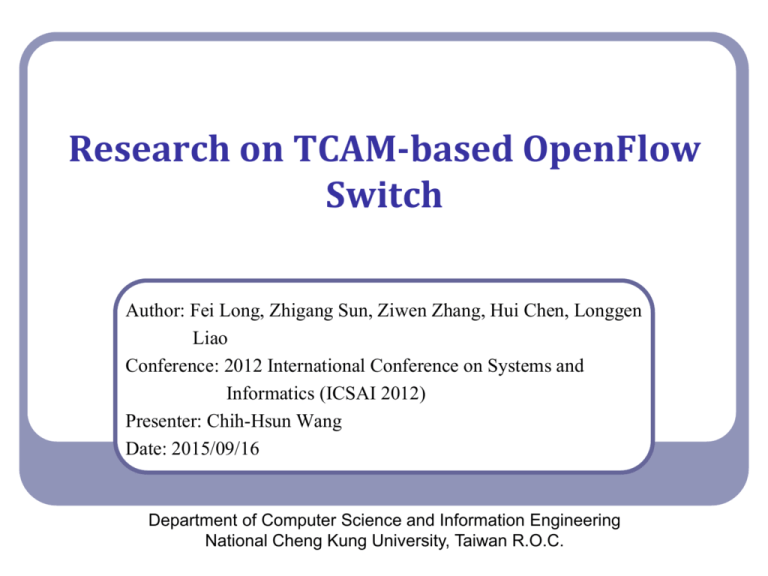
Research on TCAM-based OpenFlow
Switch
Author: Fei Long, Zhigang Sun, Ziwen Zhang, Hui Chen, Longgen
Liao
Conference: 2012 International Conference on Systems and
Informatics (ICSAI 2012)
Presenter: Chih-Hsun Wang
Date: 2015/09/16
Department of Computer Science and Information Engineering
National Cheng Kung University, Taiwan R.O.C.
Introduction
Multi-table and multi-item group matching is the
challenge in Openflow platform.
This paper presents a three-layer realization
model of Openflow switches, TCAM-based
multi-table forwarding.
The Openflow multi-table description and the
performance analysis of TCAM lookup function
is proposed.
Netlogic's Ayama20000 TCAM is used as an
example to anaylize the performance of Openflow
switch.
National Cheng Kung University CSIE
Computer & Internet Architecture Lab
2
The Design of Three-layer Model
After the release of version 1.1 specification,
Openflow has increased multi-table, the port
group, scalable matching and other new features.
But based on the new specification, less switch
models can be realized.
According to the characteristics of the new
specification, we have designed a three-tier
structure based on hardware layer, core layer, user
layer to realize.
National Cheng Kung University CSIE
Computer & Internet Architecture Lab
3
The Design of Three-layer Model
Hardware Layer
Uses TCAM and related SRAM to realize to
lookup ACL rapidly and to routing table.
Realize accelerating logic functions by FPGA
chip in hardware receiving and transmitting,
meanwhile, implement packet analysis in
hardware receiver modules by which to lookup
hardware or software according to the rules of
OpenFlow.
National Cheng Kung University CSIE
Computer & Internet Architecture Lab
4
The Design of Three-layer Model
Core Layer
Sets five modules:
• Rule management process
• OpenFlow rule table
• OpenFlow rules mapping table
• Forwarding thread management
• Statistical counters.
• to achieve OpenFlow specifications for each flow, flow table
and port, etc.
National Cheng Kung University CSIE
Computer & Internet Architecture Lab
5
The Design of Three-layer Model
User Layer
The main achievement is the user-layer
OpenFlow controller, users can change switch
configuration by controller.
These three-layer models can not only achieve
fifteen fields to complete the current matching,
but also can support the current use of the normal
rules of network data packets.
National Cheng Kung University CSIE
Computer & Internet Architecture Lab
6
The Design of Three-layer Model
We can also configure the hardware layer over
TCAM with the Aging combined with the rules
of the core layer mapping table to achieve a better
standard of OpenFlow hard timeout and idle
timeout.
National Cheng Kung University CSIE
Computer & Internet Architecture Lab
7
Three-layer Model
Openflow controller
API
Rule
Management
Process
OF Rules
database
OF Rules table2
(Hash Tables)
User Layer
API
Forwarding
Management
Threads
Kernel Layer
Statistics
Counters
OF Rules
mapping table
Hardware
Receive
TCAM OF Rules table
(Includes multi-table,
Every field could be wildcard)
Hardware Layer
Hardware to
transmit
SRAM(Instructions and Action set)
8
TCAM Performance Analysis and Model
The following table defines the parameters associated with
TCAM character description.
Symbolic name
Units
Description
v
-
TCAM rate per second
T
ns
Clock cycle
TP
ns
Processing time for a single table
C
ns
TCAM share of beats in command
W
bit
TCAM write the bit width of each shot
number
R
ns
SRAM share return the number of
beats
B
bit
TCAM width of the base to process
packets
PE
-
The number of packet processors
9
TCAM Performance Analysis and Model
The following table describes the use of multi-table of
OpneFlow: Suppose OpenFlow switches has
<RN1,RN2~RNn> tables, each table has three subsets of
attributes <RLi,RNi,RMi>, RLi means the rules of length,
RNi means the number, RMi means the rules whether contains
the mask match, 1 means including, and on contrary for 0.
Symbolic name
Units
Description
RNi
-
The number of table
RNn
-
TCAM table in the n
RLi
bit
The length of the table
D
ns
System delay time
DS
ns
Single table system delay
E
-
Resource utilization
N
-
The total number of table
10
TCAM Performance Analysis and Model
clock cycles
process time
for a single table
11
TCAM Performance Analysis and Model
TCAM Performance Analysis
By deriving the performance of TCAM can get the
forwarding rates and the total number of resource
occupying of different tables.
The TCAM with maps to TCAM, the length are RL1, RL2
~ RLn for each. The clock period is T, Then we can get the
rate of per second by formula.
12
TCAM Performance Analysis and Model
TCAM Performance Analysis
We can multiply the table’s length RLi with its
number RNn to get the total numbers of the occupying
resource rate of inner TCAM.
13
TCAM Performance Analysis and Model
TCAM-based packet processor set
Each TCAM has a different type of bus bandwidth, if we
want to make full use of TCAM, its bus can’t be idle.
We need to calculate the delaying time of TCAM, then to
design a reasonable PE according to delay.
In order to solve the problem, we designed a general
TCAM model.
14
TCAM Performance Analysis and Model
TCAM-based packet processor set
First, get a general system delay.
Second, we can get the entire processing time that
message through TCAM.
single table
system delay
TCAM width of the
base to process packets
Secondly, we can get the message through the entire
TCAM processing time required:
processing time
for a single table
15
TCAM Performance Analysis and Model
TCAM-based packet processor set
We set a period : a, then we get the following formula:
Number of packet
processors
16
TCAM Performance Analysis and Model
The parameter calculation of Ayama20000
There are four tables in Openflow switch:
T1 = <128, 8K, 1>; T2 = <64, 8K, 1>; T3 = <512, 4K, 1>;
T4 = <512, 2K, 1>, TCAM in Ayama20000 series
writes width W = 32, C = 1, R = 1, DS = {2, 4, 8, 8}
17
TCAM Performance Analysis and Model
The parameter calculation of Ayama20000
We use 128bit packet processing width with different
clock cycles to obtain the following graph:
18
TCAM Performance Analysis and Model
The parameter calculation of Ayama20000
with 64bit, 128bit, 512bit packet processing width and the
same clock cycle, as following graph:
19
TCAM Performance Analysis and Model
The parameter calculation of Ayama20000
with 64bit, 128bit, 512bit different packet width of three
tables and the clock cycles of 100MHz ~ 700MHz to calculate
20
Design and Implementation of TCAM-Based
The TCAM-based establishment of multi-table
Ayama 20000 contains a core with 9M or 18M.
The core supports 256K72-Bit 18M, 128K72-Bit 9M.
Each TCAM has 72bit data fields and 72bit mask field.
To complete OpenFlow with 18M of TCAM, they can be
512K, 256K, 128K, 64K and 32K with the width of
32bits, 72bits, 144bits, 288bits and 576bits width.
Compare with OpenFlow, its fields contain 356bit.
21
Design and Implementation of TCAM-Based
The TCAM-based establishment of multi-table
However, in the flow table, including 15 fields, two
timeout bit, group, port and queue, which means position
and handle position with 576bit.
The Ayama 20000 have two QDR™SRAMs, we can
store instruction set in OpenFlow’s management.
22
Design and Implementation of TCAM-Based
The TCAM Aging-based Timeout achievement
TCAM Aging helps to track the currently used table.
Ayama 20000 supports aging with 256K at most, these
tables may exists in one, two, or four lookup tables, which
have an aging memory module to store aging information.
The module is partition SRAM of 4K *64bit. Every bit in
it corresponds to a lookup table to store aging information.
23
Design and Implementation of TCAM-Based
The TCAM Aging-based Timeout achievement
The aging table divides into two models:
First, the single buffer mode which processes the same
time with reading aging mechanism. The model has two
settings. One reads information for a period of time, and
then stop to age. Then go on reading the whole table.
Second, the double buffering mode. Table A is divided
into A, B parts. To complete reading and aging alternately
at the same time by A, B table reading each other. But the
model must be limited in 32K.
24
Design and Implementation of TCAM-Based
The TCAM Aging-based Timeout achievement
OpenFlow are idle timeout and hard timeout, their relative
setting as following:
•
•
•
•
If the idle timeout configured, the idle timeout setting will age
without receiving dataflow.
If hard timeout sets, it ages, no matter received the data flow or
not.
If both set, the flow will age without data flow via the time of idle
timeout or aging after hard timeout, no matter which one gets
first.
If neither sets, the table will be effective permanently without
overtiming, but you can remove list item by the data packets of
OFPFC-DELETE. .
25
